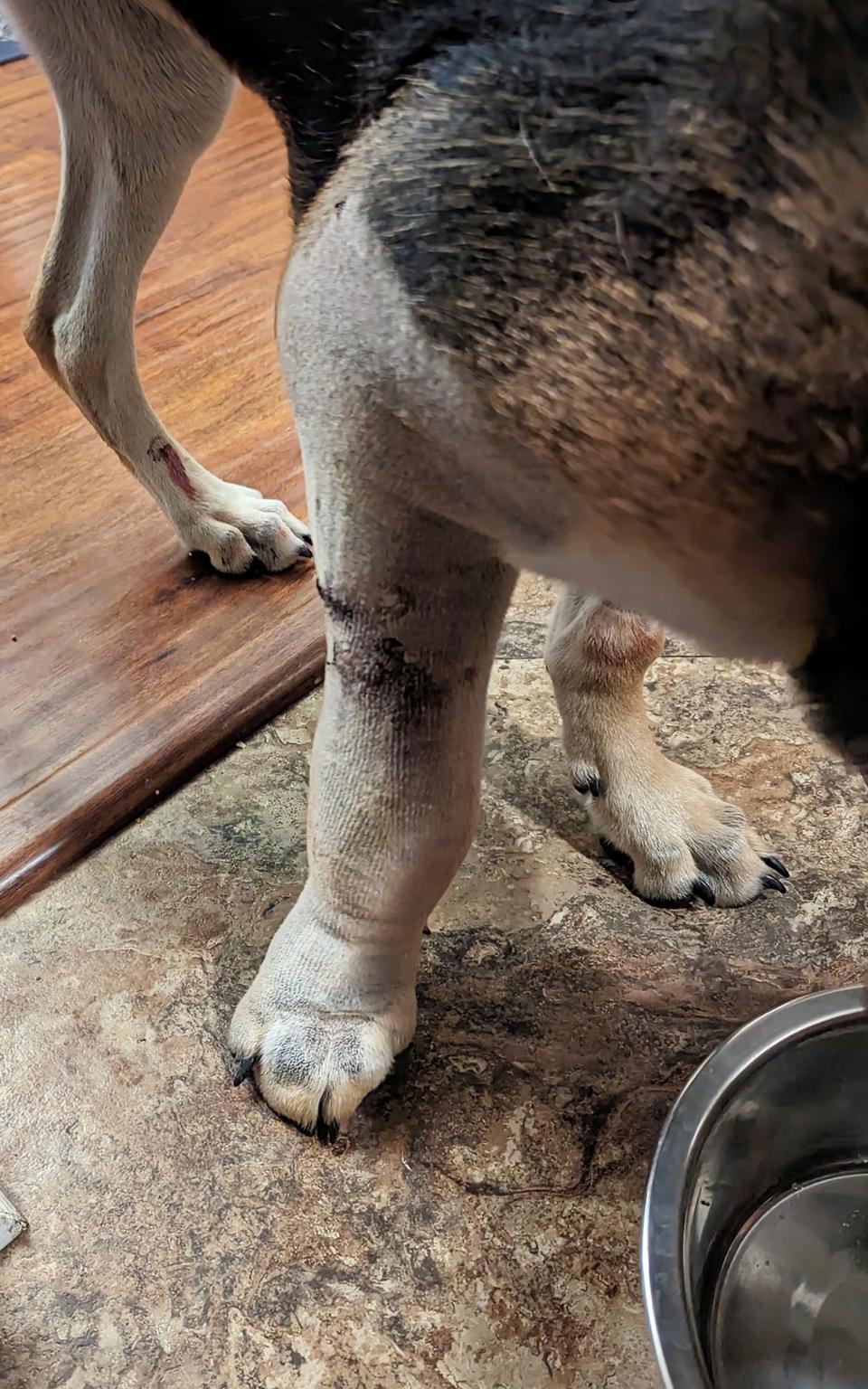‘Do I suck her leg? I totally will!’ York couple’s harrowing tale of dog bit by rattlesnake
It had rained that Saturday morning, June 24, but by noon, the weather had cleared, and Greg and Amanda Alloway resumed working on the grounds of the family’s cabin in the mountains of Cameron County.
The round earthbag cabin – about 30 feet in diameter with a steel silo cap serving as its roof – sits in the middle of a clearing, surrounded by acres of forest. It is remote; the closest town, Emporium, the county seat of the sparsely populated county, is about a 20-minute drive down the mountain.
It was a working vacation for the Conewago Township couple. Both Greg and Amanda are teachers – Amanda is a reading specialist at Northeastern and Greg teaches fifth grade at Central York’s Sinking Springs Elementary School – and they planned on spending some of their summer vacation working on the family cabin, a project that has been years in the making.
Greg was digging a drainage trench at the edge of the clearing, accompanied by the couple’s two dogs – their older dog, Josie, a mixed lab, and their five-month-old puppy, Mabel, a coon hound/golden retriever/lab mutt. Josie was on his right and Mabel was to his left, tethered to a 50-foot lead to prevent the rambunctious puppy from running into the woods and getting lost.

Mabel was about 10 feet away from Greg, near a bush, when he saw the puppy jump and start running. Mabel didn’t yelp or make any noise, but she was hurt. Amanda came to her aid and saw what she described as “prick marks” on her right front leg. She thought that Mabel had run into a thistle and got tangled in the plant's barbs.
But as she looked closer, she saw two puncture wounds about an inch apart.
Greg walked over to the bush and that’s when he saw it.
“It’s a rattlesnake,” he told Amanda.
The three-foot-long timber rattler reared up its head and began rattling. He backed away and ran to his truck. By then, Amanda already had Mabel in the truck.
They had to get to a veterinarian.
Snake bites are rare
Timber rattlers are one of three venomous snakes that reside in Pennsylvania. The others are copperheads, the state’s most common venomous snake found in a variety of habitats throughout the commonwealth, and the eastern massasauga, whose habitat is limited to a few western Pennsylvania counties.
Timber rattlers are found mostly in mountainous areas of the state, preferring woodlands with rocky outcrops, according to the state Fish and Boat Commission. They are considered what’s called a “candidate species,” which means they are on the verge of being a threatened species.
Timber rattlers are not aggressive and usually strike only as a last resort to defend themselves against what they perceive to be a threat, the commission reports. Timber rattler bites can be painful and life-threatening, but they are rare. Maybe two or three bites are reported every year, according to the Fish and Boat Commission, and there hadn’t been a human fatality from a bite in more than 25 years when, in May 2020, a 39-year-old Elk County man died of a snake bite, going into cardiac arrest after being administered anti-venom serum.
The instances of dogs or other pets being bitten by timber rattlers may be more common. Reliable statistics are not available; they range from fewer than 100,000 to more than 300,000 a year nationally, depending on the source, with most of those reported from the South and the West where poisonous snakes are more prevalent.
There are no reliable statistics for Pennsylvania, but anecdotal evidence, and the fact that venomous snakes are fairly rare in the state, suggests they are rare.

'Do I suck her leg?'
The Alloways raced down the mountain to Emporium, “our first mistake,” Amanda said. They learned that the town of 2,000 doesn’t even have a veterinarian’s office. They drove to the nearby state police barracks, where a trooper suggested that they go to the Elk County Veterinary Hospital near St. Mary’s.
They raced to St. Mary’s, about half hour away.
By now, they said, Mabel was in bad shape. She had lapsed into unconsciousness and had lost control of her bowels. Greg asked Amanda, “Is she still breathing?”
Her leg had swollen, almost as thick as Amanda’s forearm. Her breathing was labored. She appeared to be close to death and they feared they would lose her. Amanda thought about administering first aid herself. “All I know about snakebites is from the movies,” she said. “Do I suck her leg? I totally will. Do I put a tourniquet on it?” She didn’t do either, which was a good decision. You can’t suck the venom out of the wound – it is already in the bloodstream – and putting a tourniquet on her leg would have caused more damage than not, she learned later.
The clock was ticking.
When they arrived at the Elk County vet’s office, it was closed. An emergency phone number was posted on the door, and they called it. The vet called back quickly and told them that the office did not stock antivenom serum and that they had to get Mabel to a veterinary hospital. The closest one was in State College, Central Pennsylvania Veterinary Emergency Services, about an hour and a half away.
Mabel had appeared to go into shock. She was shaking and was struggling to breathe. She seemed close to crossing the rainbow bridge.
In this kind of crisis, 10 minutes can make the difference between life, and death and by the time they arrived at the veterinary hospital in State College, it had been about two and a half hours since Mabel was bitten.
The vet techs took Mabel to a room immediately. As the vet tech carried Mabel to the room, she wagged her tail. “She loves people so much,” Amanda said.
The vet gave Mabel some pain medication and started the half-hour-long infusion to administer the antidote to the venom coursing through her bloodstream. She bled profusely, the snake venom preventing her blood from coagulating. The swelling had spread from her leg to the right side of her chest. The vet told them Mabel might lose her leg. She would be “a tripod puppy,” the vet told them.

Dogs are curious, and that's how they get bitten
Andrea Loar, the chief medical officer with Central Pennsylvania Veterinary Emergency Services in State College who treated Mabel, said the practice sees perhaps one or two a month during the summer, when the rattlers in the mountains are more active.
Dogs seem to get bitten more often, she said, because they wander off the paths in the woods and stick their noses in places where the rattlers hide. “Dogs,” she said, “are curious, and when they see something moving, they go toward it to see it they can play with it.”
She said, “Ideally, the serum would be administered within 30 minutes to two hours. In Mabel’s case, there was a delay, which was no fault of (the Alloways).”
Felicia Hansen, a nurse with the Mason Dixon Animal Emergency Hospital in Shrewsbury, has a lot of experience with snakebites. She's originally from Colorado, where she said vets would see dogs with snakebites "every day." There, she said, they have diamondback rattlers, which are much more aggressive that timber rattlers or copperheads. "The snakes around here," she said, "are not really aggressive, only if you mess with them. They have to be agitated to bite."
Still, she said, poisonous snakebites in southcentral Pennsylvania, habitat for copperheads, are fairly rare and the hospital sees maybe two or three a year.
'We thought we'd have to make a hard decision'
That Sunday morning, the vet’s office called and told them that Mabel wasn’t responding to the antivenom serum. “It was touch and go,” Amanda said. “She had a rough night. We thought we’d have to make a hard decision.” Mabel was still in a lot of pain and her blood was not coagulating, the vet told them.
“We assumed that was going to be it,” Amanda said − Mabel wasn't going to make it.
The vet asked them whether they’d like to administer a second infusion. Cost was a factor. The antivenom costs $650 a dose, and before Mabel was treated, they had to sign a form that committed them to pay the bill, which ended up being about $3,000. They approved it − “We’re big dog people,” Amanda said – and after the second dose, Mabel appeared to be doing better.
Mabel would pull through. And she would keep her leg.
More dog news: Here are the 11 most popular dog names in York County - plus some of the weirdest
'Not many as severe'
In the aftermath, Amanda and Greg called around to veterinary offices in York County to see whether they stocked antivenom serum. Most did not. The demand is slight, for one thing, and it’s very expensive. Few veterinarians believe it’s worth the cost to stock something that they would need to administer only in very rare circumstances.
“I’m from Hagerstown, Maryland,” Loar said, “and we don’t see them there. They’re more common up here.”
In some cases, when dog owners can’t afford the serum, vets treat the symptoms and the outcomes are usually good, Loar said. “It’s a very survivable injury.”
But, she said, “Not many are as severe as Mabel’s was.”

The passing of a great dog: Delmer, the Secretariat of greyhounds: He was fast. And goofy. And now he's gone.
'She's a good girl'
The swelling began to subside in a few days, and it wasn’t long before Mabel was back to being a puppy. “Within two days,” Greg said, “we were struggling to keep her from running and playing. We thought we’d have such a calm puppy for a few days.”
Two weeks after she was bitten, she seemed back to normal, for a puppy. She’s a friendly dog and very puppy-like, excitable and affectionate. She has a lot of energy. You could still see the scars from the puncture wounds on her leg.
“She’s a good girl,” Amanda said. “She’s doing quite well, despite the trauma.”
Reflecting on those two days, Amanda said, “It definitely wasn’t the adventure we planned on.”
Columnist/reporter Mike Argento has been a York Daily Record staffer since 1982. Reach him at mike@ydr.com.
This article originally appeared on York Daily Record: York County Pa. couple’s harrowing tale of dog bit by rattlesnake

